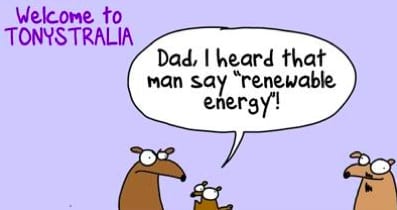The dangerous thinking behind Coalition renewable energy policyBy Giles Parkinson on 29 August 2013
The
Coalition’s admission this week that it had thrown the Australian Renewable Energy Agency into the basket of climate change and green energy programs to be cut if elected should not have taken people by surprise, because they have been hinting at it for a few months.
But it does raise questions about where the Coalition is heading with its energy policies, and why there appears to be such deliberate moves to wind back support mechanisms for wind energy and solar, and other emerging renewable technologies.

Source: First Dog On The Moon, Crikey
Part of the problem may be in the quality of the advice it is receiving. Many in the Coalition defer to the Institute of Public Affairs when asked about climate change and renewables policies. The IPA, of course, is a right-wing think tank that doesn’t accept the science of climate change, and argues against climate and clean energy policies.
More recently, Greg Hunt has been using the work of Bjorn Lomborg to justify Direct Action. Lomborg, as we discussed in
last month’s piece, is known for downplaying the dangers of climate change, for arguing that renewable energy should not be deployed until costs are reduced in research labs, and for suggesting that wacky “geo-engineering” schemes such as cloud whitening should be priorities.
That may explain why the Coalition is now targeting ARENA, whole job it is to help take technologies out of the lab and actually deploy them. The Coalition also intends to shut down the Clean Energy Finance Corp, which plays a similar role, as well as the Climate Change Authority, which conducted last year’s review of the Renewable Energy Target. The Coalition wants the RET to be reviewed yet again, but not by the CCA. The uncertainty is already causing Australia to
fall down the ranks of investment attractiveness.
Another document that may be influential in Coalition thinking was circulated in recent months by one of its so-called “star” candidates, Angus Taylor, the anti-wind campaigner who is seeking election in the seat of Hume in NSW.
The document was put together under the banner of Port Jackson Partners, the consultancy where Taylor used to work. The central theme of the report is that the Coalition could drop the renewable energy target entirely (and immediately), save up to $3.2 billion (or up to $300 a household) by 2020 and still meet emissions reduction targets. But it’s based around a whole series of false assumptions. It is more likely to push up costs by around $1 billion a year.
The first assumption is on the issue of costs. As is typical of such documents, it gives a bleak picture of renewable costs and a rosy picture of fossil fuels. It says that wind costs are virtually double that of gas. But the reality is that there is, and will be, very little difference between the two.

First of all on wind. As the above graph shows, Taylor reckoned the cost was around $120/MWh, but the wind industry will tell you it is around $100/MWh at most. Some agreements have been struck at around
$90/MWh or even lower. (In Brazil, an auction of capacity announced this week
will see 1,500MW of wind energy built at around $US46.57/MWh. In the US, prices are even lower. These lower costs are helped by the fact that they have local production – something Australia had until the previous Coalition government brought the then MRET to a crashing halt in 2005).

But the estimates that gas will be around $65 are contradicted by one of Port Jackson’s own documents,
produced in November 2011, which suggested that the long run cost of gas will be pushed up to $90/MWh (see graph to the right) by a jump in gas prices caused by the LNG boom. That estimated is based on the prediction that gas will double to around $8/gigajoule. But, already, forward gas prices are being bid at $9-10/GJ in the Queensland market, so the cost of gas generation could be even higher.
The second major problem is a lack of understanding about how the National Electricity Market actually works. For a gas plant to operate, as Taylor’s document suggests, at 85 per cent capacity – and so achieve the emissions reductions claimed by Port Jackson – two things would need to happen in the NEM.
[continued ...]

 Forum
Forum

 Home
Home 

 Album
Album 

 Help
Help

 Search
Search

 Recent
Recent 

 Rules
Rules 

 Login
Login

 Register
Register





 Pages: 1
Pages: 1

